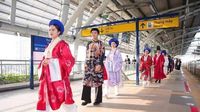On April 26, 2025, Ho Chi Minh City celebrated a significant milestone by opening an exhibition that showcases 50 exemplary works of literature and art, 50 notable construction projects, and 50 outstanding events and activities from the city’s rich history. This exhibition commemorates the 50th anniversary of the Liberation of the South and National Reunification, marking a pivotal moment in Vietnam's history that took place on April 30, 1975.
The event was attended by prominent leaders from the City Party Committee, the People's Council, the People's Committee, and the Vietnam Fatherland Front Committee of Ho Chi Minh City. Nguyen Thi Le, the Deputy Secretary of the City Party Committee and Chairwoman of the Ho Chi Minh City People's Council, emphasized that the victory in Spring 1975 ushered the country into a new era characterized by peace, unification, independence, freedom, innovation, and development.
"This exhibition serves to introduce the city’s typical works, events, and projects to the citizens, tourists, and international friends," Le stated during her opening remarks. The exhibition included a short film that highlighted various areas within the exhibition space, offering visitors a glimpse into the city’s artistic and cultural accomplishments.
Among the 50 literary and artistic works honored at the exhibition, many were selected to recognize their significant contributions to the development of literature and art in Ho Chi Minh City over the past five decades. These works celebrate the creativity and dynamic spirit of the city’s artists and writers.
Additionally, the exhibition honored 50 construction projects that represent not only physical achievements but also the intellect and dedication of architects, engineers, and workers who have contributed to the city’s urban landscape. These projects have helped shape a modern, vibrant, and innovative urban environment.
The exhibition also highlighted 50 outstanding events and activities that have defined Ho Chi Minh City, ranging from the historic Ho Chi Minh Campaign to the first session of the VI National Assembly, which officially renamed Saigon-Gia Dinh to Ho Chi Minh City. These events are seen as milestones in the city’s journey towards modernization and growth.
Le further noted, "These events and activities reflect the determination and unity of the Party, government, and people of the city across various sectors, including politics, economy, culture, society, defense, and security. They collectively contribute to making Ho Chi Minh City a modern, civilized, and compassionate urban center."
The opening ceremony also featured an exchange program that included notable figures associated with the 50 highlighted events and activities. Participants included Pham Chanh Truc, former Deputy Secretary of the City Party Committee, and Nguyen Van Tau, a historical figure recognized for his contributions to the city’s development.
In addition to the exhibition, the Ho Chi Minh City Department of Tourism is implementing a series of meaningful activities to celebrate this historic anniversary. One such initiative is the introduction of a photo collection titled "50 Symbols of Ho Chi Minh City," created by photographer Cao Ky Nhan. This collection captures the city’s vibrant essence, blending its historical and modern attributes.
According to the Ho Chi Minh City Department of Tourism, the photo collection is the result of over two months of work by Nhan. It creatively depicts the beauty of the city through various lenses, showcasing historical landmarks like the Independence Palace and the City Post Office, alongside cultural gems such as the City Theater and the Fine Arts Museum.
The collection also features bustling markets like Ben Thanh Market and Binh Tay Market, lively streets such as Nguyen Hue Walking Street and Bui Vien Street, and serene green spaces like Dam Sen Cultural Park and Anh Sao Bridge Park. Each photo tells a story and connects people to their living environments, illustrating the unique character of Ho Chi Minh City.
Moreover, the collection incorporates the logo for the 50th anniversary, which creatively combines two heart shapes—one blue and one orange. These colors symbolize peace, aspiration, and the dynamic spirit of the city. The logo features the number "50," representing not only a milestone but also a source of inspiration for the city’s ongoing development.
"Hidden within each heart is one of the 50 typical tourist symbols, arranged to form the number '50'. This is not just a number of remembrance, but also a milestone that inspires a city that continues to grow, connecting its past with its future," the Ho Chi Minh City Department of Tourism remarked.
The exhibition and associated activities aim to evoke a sense of pride among residents and visitors alike, highlighting the city’s journey over the past 50 years. As Ho Chi Minh City continues to evolve, these celebrations serve as a reminder of the resilience and creativity that define its character.
In summary, the exhibition not only honors the significant achievements of the past but also sets the stage for the future, inviting all to witness and participate in the ongoing narrative of Ho Chi Minh City.

